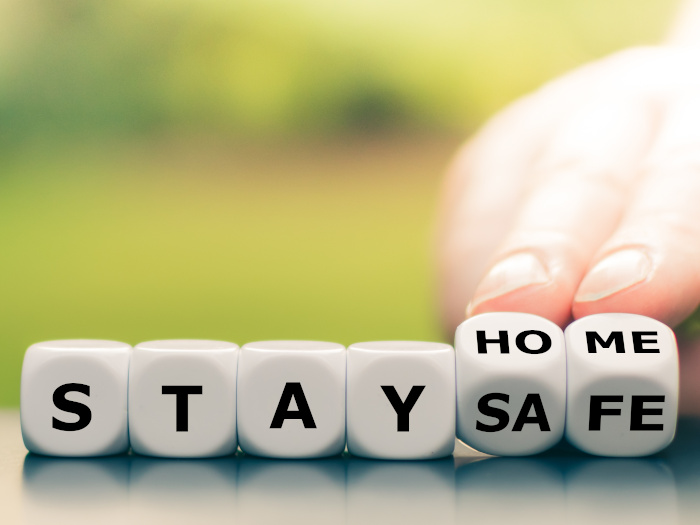We live in a hyper-connected world. While it has innumerable advantages, there is one drawback to our planet, the danger of the spread of diseases. Where an epidemic would be confined to a small region because of geographical restraints, it is almost impossible today. This is when a ‘stay at home’ order is issued by authorities. A situation like a pandemic requires an almost global lockdown. The idea is that by staying at home you are protected from infections and the spread of the infection is controlled. Apart from pandemics, stay at home orders can also be issued during times of social unrest.
Why Stay at Home?
A stay at home is a mass quarantine strategy where people are confined to their home. Governments allow only essential and selected non-essential activities to take place. It is usually imposed through a formal government order. The severity of the order can vary from place to place. It can range from a full curfew to just curtailment of public gathering. The degree or severity is decided as per the risk associated. There are certain reasons behind such a strategy, such as:
- It ensures that infected people are quarantined.
- It can protect the vulnerable by keeping them isolated.
- It gives authorities the time to prepare for adequate infrastructure should an outbreak occur.
- It gives scientists valuable time to look for vaccinations.
- In the case of social unrest, it ensures that there is no mob mobilization.

Staying at home can save lives. Photo Credit: Shutterstock
Preparing Your Home
Stay at home orders are not easy to follow. While a brief period is manageable for most people, a long spell of isolation can take its toll. To make this easier, the CDC recommends a household plan of action. The UK government site has similar recommendations. Both of these guidelines were issued after a COVID-19 outbreak that called for national and global lockdowns. [1] [2]
- Communication: You have to start with clear communication at home or in your community on the scope and implications of such an order. Young children must understand how their activities will be curtailed and older people should be informed of the reasons and manner of the lockdown.
- Identify the vulnerable: You must be extra vigilant if you have vulnerable people at home, such as the elderly or immunocompromised. Make sure they are kept strictly under segregation. Know the symptoms you must look out for. Talk to their healthcare providers to know what precautions you should take.
- List emergency services: Always keep a list of emergency services. This includes healthcare providers, local testing/treatment centers, family members, and friends who can be reached quickly.
- List essential service providers: In most lockdowns, the government would allow for essential services to remain open. There are also aid agencies that can help in such situations, especially for elderly, sick, or quarantined people.
Protecting Others at Home
You need to be extra diligent if you have vulnerable people at home. If you are involved in essential services that require you to leave home, you need to ensure that others at home are protected from any potential exposure from you. We have compiled a list that includes NHS and CDC recommendations you can take to protect others at home: [3]
- Practicing preventive action: Start off by insisting that everyone follows basic preventive practices at home. Cover your nose while sneezing, wash your hands with soap and water frequently or anytime you touch any object from outside, and use a face mask if you have to step out. You should also follow the right procedure in sanitizing grocery bags and food.
- Using separate bathrooms: If you or anyone in the house has to work outside, make sure that there is a separate bathroom for them to wash up. Do not share towels and other personal hygiene products.
- Minimizing contact: If there are any chances of infection entering your home, it is best to follow segregation practices. It is always best to minimize contact with a sick person at home or anyone who has to step out to work. If possible, assign a separate room and minimize contact.
- Staying at home: The best way to protect your loved ones is to stay at home. Use the phone or internet chats to connect with others. Use deliveries for supplies as much as you can.
- Living with vulnerable people: The UK government has detailed guidelines on how to live with a vulnerable person or people with low immunity. Minimize contact by ensuring that they do not come out in common areas and keeping these areas well-ventilated. Make sure common surface areas, such as kitchen counters are always kept clean.
Tips on Staying at Home:
Ask any parent who works from home or stays in to take care of kids, it’s not easy! It can be especially challenging if you have small children, pets, or vulnerable people like pregnant/breastfeeding women, and the elderly. Some of the tips you can follow to ease the situation are:
- Dealing with children: Even with online classes, keeping children occupied indoors can be a problem. One of the ways you can keep them entertained is by starting a new project, such as a craft activity. Involve them in cooking, gardening, and the general housekeeping tasks.
- Pets: The good news is that not all human infections affect pets like cats and dogs. However, pets like dogs need some outdoor time. Check if you can take them out. If not, create a play area in your yard or balcony.
- Creating workspace: Switching to work mode can be difficult when working from home. Creating a dedicated workspace can help in this. It can be a room or just a nook where you feel comfortable. Make a timetable that echoes your working day life and try to stick to it.
- Be comfortable: Do things that give you pleasure and comfort, be it reading, writing, cooking, gardening, watching the TV or listening to radio. A good meal, lovingly prepared, can boost your spirits.
- Do light exercises: A lockdown limits your outdoor exercises, including the gym. So, make sure that you do some light exercises at home. Our article on at-home workouts gives you some simple exercises for your back. [4]
- Self-care: Caring for your well-being also means caring for your mental health. Staying home for a prolonged period can be stressful. Follow our tips for stress management and self-care.
Remember, this is a temporary situation. Stay home, stay healthy, and stay safe.
COVID-19 is an emerging, rapidly evolving situation.
Get the latest public health information from CDC.
Get the latest research from NIH. [5] [6]
